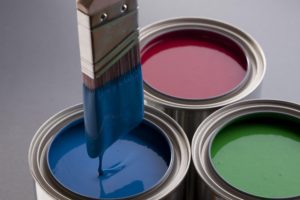Attempting to buy paint can be overwhelming if you”™re a home improvement novice; there are so many options and very little direction. Paint cans carry labels like high gloss, satin, premium, eggshell, oil and alkyd, but they lack any description as to what those labels actually mean. Understanding the difference between interior and exterior paint only adds to the confusion. To help make sense of this plethora of options, we”™ve put together a list of interior and exterior paint buying tips.
Tips That Apply to Both Interior and Exterior Paint Purchases
While painting tips differ for interior and exterior jobs, some overlap does occur. The characteristics of a high-quality paint are the same, regardless of where it”™s being applied. High-quality paints usually have a higher pigment concentration, which allows painters to apply fewer coats, while still achieving an excellent finish. They also tend to have higher resin content, which makes them more durable. We recommend always spending the extra money on quality paint.
The other commonality in exterior and interior paint buying is color choice. Choosing a paint color is a big decision, and you will likely have to live with the results for quite some time. In order to minimize the potential for disappointment, it’s best to find several colors you”™re interested in and purchase samples. Paint these on paper for your home’s interior or wood for the exterior and hang them up. This way, you”™ll be able to live with the colors and see how they react in different levels of light before committing.
Guide to Purchasing Interior Paint
The outcome of your interior paint job relies heavily on the sheen you choose and whether or not it is compatible with the surface you are painting. For simplicity, we have broken down sheens and their uses into categories.
Flat/Matte– This type of finish hides imperfections very well, making it the perfect solution for worn surfaces. It is also more prone to staining and showing dirt, which means it is better suited for low-traffic areas of your home. It has high light absorption, making areas appear darker.
Egg Shell– This type of paint provides a soft, smooth finish. It”™s more durable than flat finish, but still is susceptible to scratches and other marks. Egg shell makes a great living room paint.
Satin– Satin also provides a soft, smooth finish. It”™s durable enough to withstand light cleaning and dries elegantly, making it ideal for kitchens and children’s rooms.
Gloss/Semi-Gloss– Gloss and semi-gloss are the most durable finishes available, but are also most prone to showing imperfections. Their application is best on smooth, clean surfaces that are free from scratches and scuffs. Once they have been applied, both are highly resistant to abrasion and withstand abrasive cleaning, which makes them ideal for doors, bathrooms, and floor trim.
Guide to Purchasing Exterior Paint
Unlike interior painting, the outcome of your exterior paint job relies more on paint composition, rather than sheen. Making the right choice between oil-based (alkyd) paint and water-based (latex) paint should be your top priority.
Oil-based paints are made from solvents and natural or artificial oils, which gives them a durable finish.
This is the “traditional” paint composition, and it is commonly used to paint over the exteriors that were previously coated in oil-based paint.
The downside to this type of paint is a longer drying time, but most homeowners would agree that the outcome is worth the wait. It”™s also worth noting that oil-based paints dry very brittle, meaning the fluctuating Colorado weather can cause them to crack.
Latex paints are made from a water base with a plastic binder. These were once considered to be inferior, but their technologies have been so well-developed that their durability now rivals that of oil paint. The main benefit of choosing water-based paint is its ability to expand and contract with the temperature of the surrounding environment. Hot Boulder days turning into cool nights are no concern for homes with latex paint. This type is also much less toxic than alkyd paint. In fact, some states have even banned the sale of certain alkyd paints.
Whether you”™re repainting your home”™s dining room or refinishing the siding, we hope this guide will make your paint purchase decision easier. It”™s not easy to navigate the world of paint, and if you”™re ever in need of a professional painting service to handle these details for you, don”™t hesitate to call us. We have almost 40 years of experience serving the Boulder area, and we would love to show you what we”™re all about.

